When people ask me for something fun and unique to do in Mexico City, the first thing that comes to mind is Sunday mornings on Paseo de la Reforma. Every Sunday, the busy roadway is transformed into a car-free thorough way. This experience of riding down this stretch of the city is both a fantastic sightseeing opportunity and an excellent chance to interact with cheery locals. All of whom are also out enjoying a peaceful bike, scooter or walk along historic Paseo de la Reforma.


Paseo de la Reforma History
Paseo de la Reforma is one of the most extensive avenues in the city. The street connects many different neighbourhoods together and feels like the veins which keep the heart of the city beating. It was designed in the 1860s after the grande avenues in Europe. It was built to connect Emperor Maximilian’s new imperial residence, Chapultepec Castle, to the rest of the city. Today, the Paseo de la Reforma is where you can still see some of the most magnificent architectural masterpieces in town. It is also one area of the city with the most exciting landscape architecture and flower arrangements.
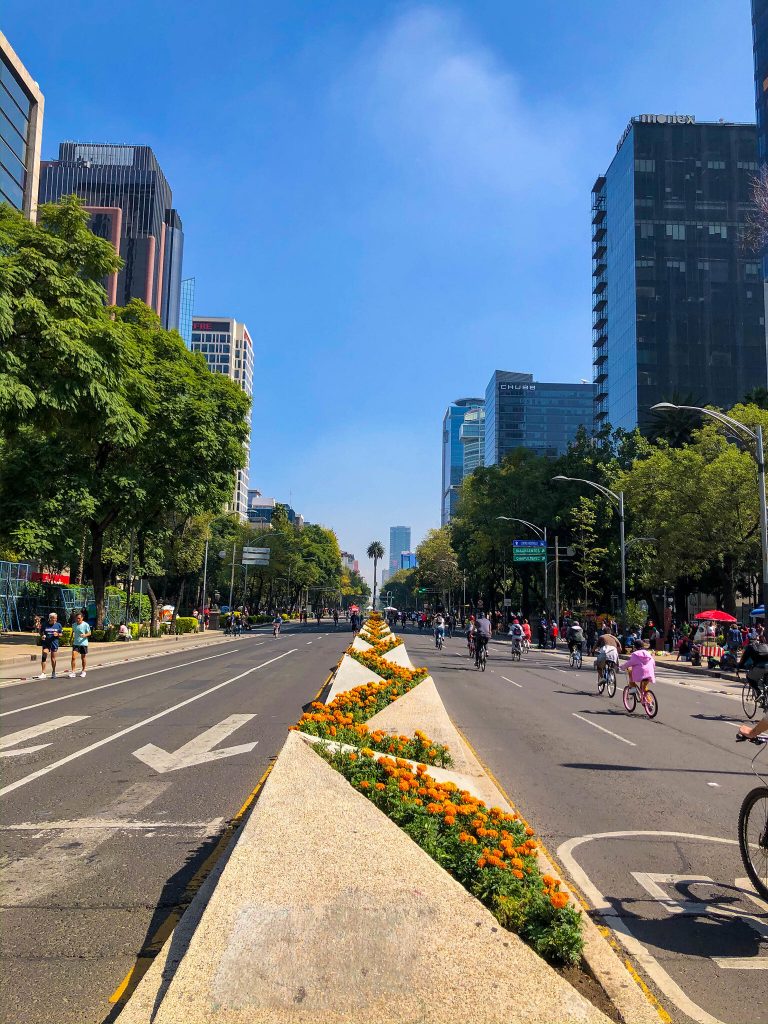
Care-Free Sundays
Most of the time, this broad avenue is one of the busiest streets in the city, with that iconic sound of honking horns and the rumble of idling cars. But on Sundays, between 8:00 am, and 2:00 pm, all cars are banned from the street and the entire roadway is dedicated to bikes, scooters, runners, and pedestrians. The whole avenue transforms, suddenly it feels almost quiet (at least in comparison to during the week.) Children can be heard laughing as they cruise down the road, perhaps learning how to ride a bike for the first time. This is definitely not a touristy event, although tourists are more than welcome. This is a community-driven initiative to bring people outside to enjoy their city together without vehicles – which in a city as busy as Mexico City, is a real treat!

I couldn’t believe this when I first saw it. This isn’t a small street, it’s enormous! I couldn’t imagine Toronto agreeing to shut down its major roadway once a week just for the community to enjoy. It would be chaos. But everything seemed to run as usual here, and thousands of people come out every week to enjoy the event! The idea for this was dreamt up by Muevete en Bici.
Organization
After their initial proposal, the government-backed the campaign to help improve the lifestyles and health of the residents of Mexico City. The volunteers who help out every week, bring these huge signs, which they spread across the streets, when they need to stop the bikers and pedestrians for through traffic. The signs announce upcoming events or give advice and tips on bike and scooter safety. Some of the volunteers are extra enthusiastic and love to sing and dance when it’s time to get going once more. They were definitely a huge part of making this event so much fun!

Free Bikes
If you’re looking to rent a bike and aren’t too fussy about its condition, then head to the Glorieta de la Palma roundabout. Get there early in the day for the best selection. At this intersection, you’ll find a large white tent where you can rent a bike for free. This is part of the campaign, and the government offers free bike rental for a maximum of two hours. All you need is ID, which they keep until you return the bike. I would bring a driver’s licenses to hand over since I know that turning over your passport can feel a bit scary, but trust me, it’s okay.
Cost of Bike Rental
You’ll fill out a form with a phone number where you can be reached. After you’ve filled out the form, you’ll be given a ticket that corresponds with your ID to get when you return the bike. Then you can head off, just be sure to return before the two hours is up, or face a 50 peso fine (albeit, that’s a very cheap fine and might be worth it for that extra bit of time experiencing the streets). Just be sure to return before 2 pm since that’s when they close down.

ECOBICI
ECOBICI is Mexico’s City public bike-sharing system. The service allows registered users to take a bike at any bike station with unlimited 45 minutes trips. This means that as long as you return your bike after 45 minutes, you’ll only have to pay the one-time registration fee. This is great since there are many stations along the route, so you can bike for a bit, return your bike, have some street food and then continue on your way with another bike, starting up a new 45-minute session. The system just requires you to register online. As a tourist, I would recommend the 1 or 3-day subscription. A 3-day subscription will cost you $208 (pesos), and a 1-day is $104 (pesos).
One day is perfect if you only think you’ll want the bike on Sunday, but if you want to do a little bit more biking, the 3-day pass is the choice for you. If you happen to go over your 45-minute session, you’ll be charged a small fee, but nothing to freak out over. These bikes are in much better condition than the free bikes and you also have the freedom to cruise around all day, instead of being restricted to 2 hours.
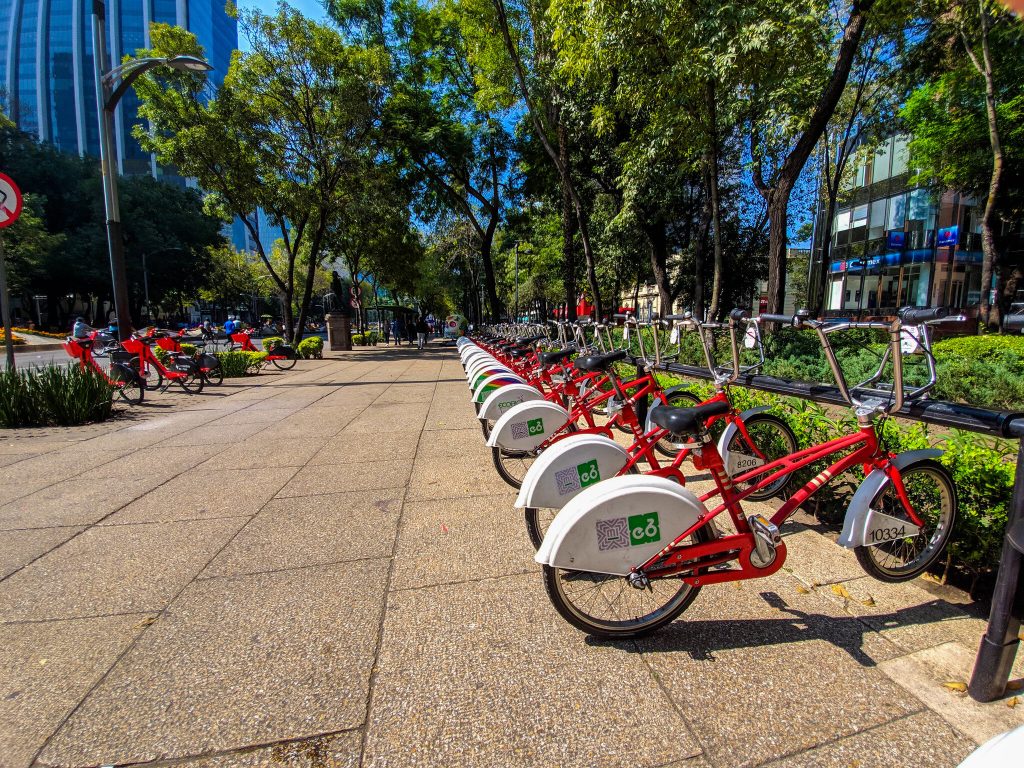
Scooter Rentals
Since we had rented bikes in the city before, we wanted to try out their new scooter rental systems. We loved renting scooters in Calgary when we visited in the Fall and so sought out some scooters for the ride along Reforma. Multiple companies rent out scooters in the city. The one we found to be the easiest to use, the most tourist-friendly and with the one with the most scooters available, was Bird Scooters. Bird is a worldwide company, so if you happen to have used the app anywhere else in the world, you’ll be fine to use it here. And you won’t need to do anything special to your account or payment settings. If you don’t have an account, you’ll just need to download the app and register with a credit card.
Cost of Scooter Rental
You will need a roaming cellular phone for these apps to work properly. I’ve tried just being on wifi to unlock and re-lock the bikes and find that too often something goes wrong, and you don’t want to be unduly charged. Use the app to find scooters near you, there are always tons, fully charged around Paseo de la Reforma on Sundays. To unlock the scooter it costs $20 pesos ($1 USD), and each minute of your ride is $2 pesos. If you choose to ride for an hour, the cost is a fixed $140 pesos ($7 USD), including the unlock fee. Use the Bird Scooter Promo Code: M3J31Y to get your first ride free!
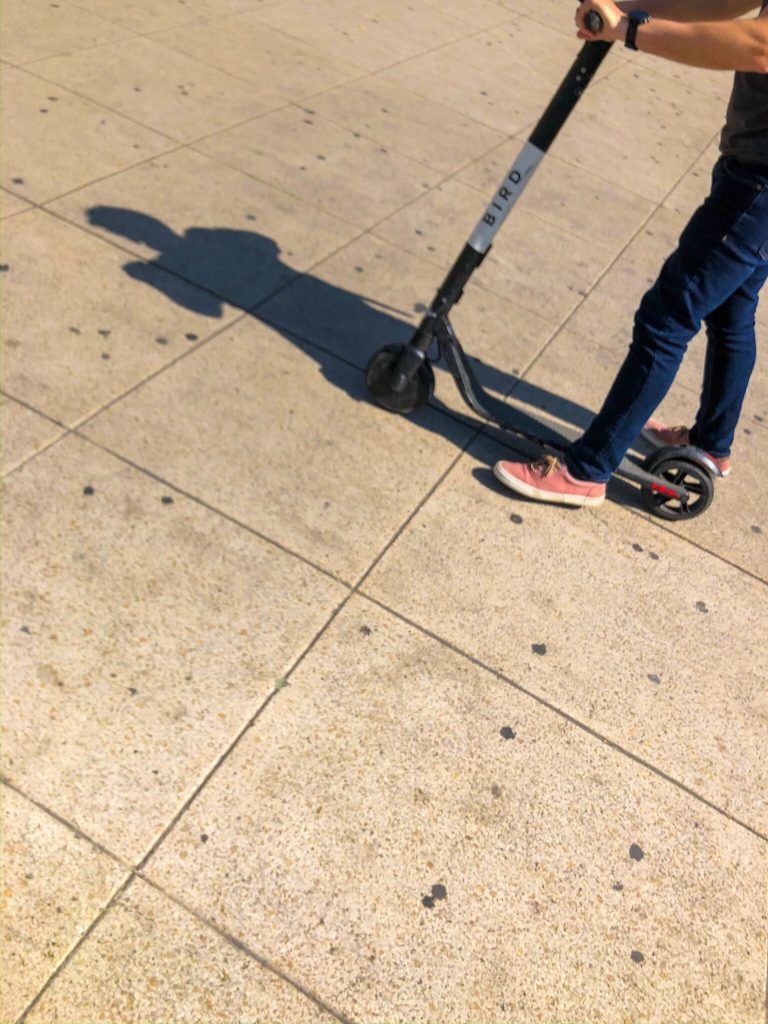
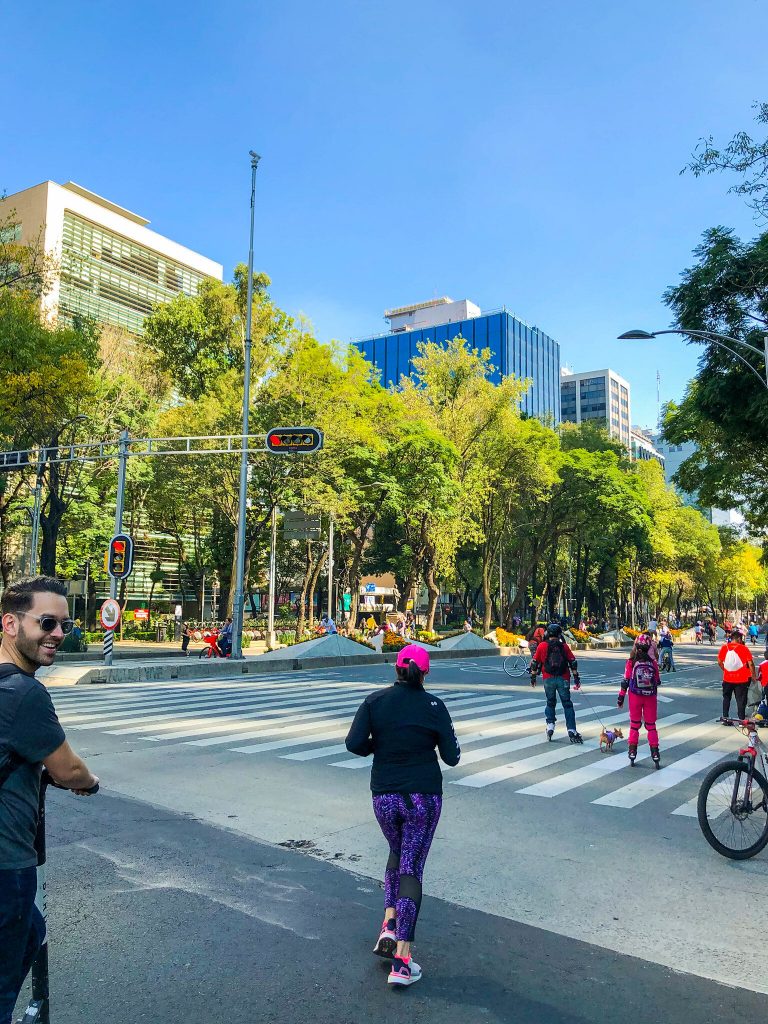
While I love biking, cruising around on the scooter felt like such a different experience, perhaps just because it was new to me. It was indescribably fun! And because the road was smooth and car-free, it felt totally safe. It was such a wonderful opportunity to try out a new mode of transportation. We loved it so we got brave enough to ride them around the rest of the city over the course of our trip, albeit on the sidewalks.

Sidewalk Fun!
On either side of the sidewalk along Paseo de la Reforma, you’ll find a variety of exhibitions throughout the year. We were lucky enough to be there at the tail end of the Dias de los Muertos celebrations. Everywhere we walked there were bright and colourful skeletons lounging on benches, peeking out of the bushes or just watching over the streets. I can only imaging how amazing it was during the actual festival!
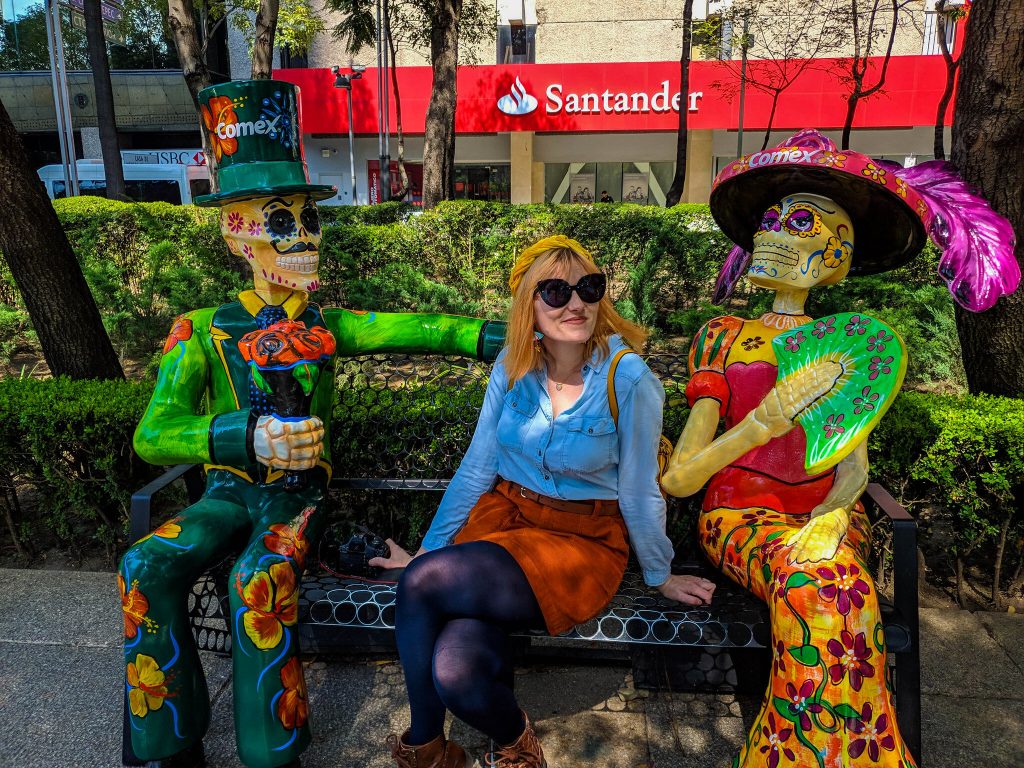
Day of the Dead
On either side of the sidewalk were enormous sculptures of the Day of the Dead skulls. Each one was the made from the same mould, but the way they were painted or decorated were entirely different, depending on each individual artist’s style. My husband’s favourite was definitely the Lucha Libre themed one, but mine, of course, were the ones embellished with jewels!


Also along the sidewalks were the papier-mache sculptures of super-sized Alebrijes. These brightly coloured folk art sculptures depict fantastical, mythical creatures. These larger than life sculptures were actually a part of the Day of the Dead parade but were put back on display here for the public to admire even if they didn’t get to attend the ceremonies. It was awesome to get up close to these works of art and study the incredible patterns which cover the creatures.
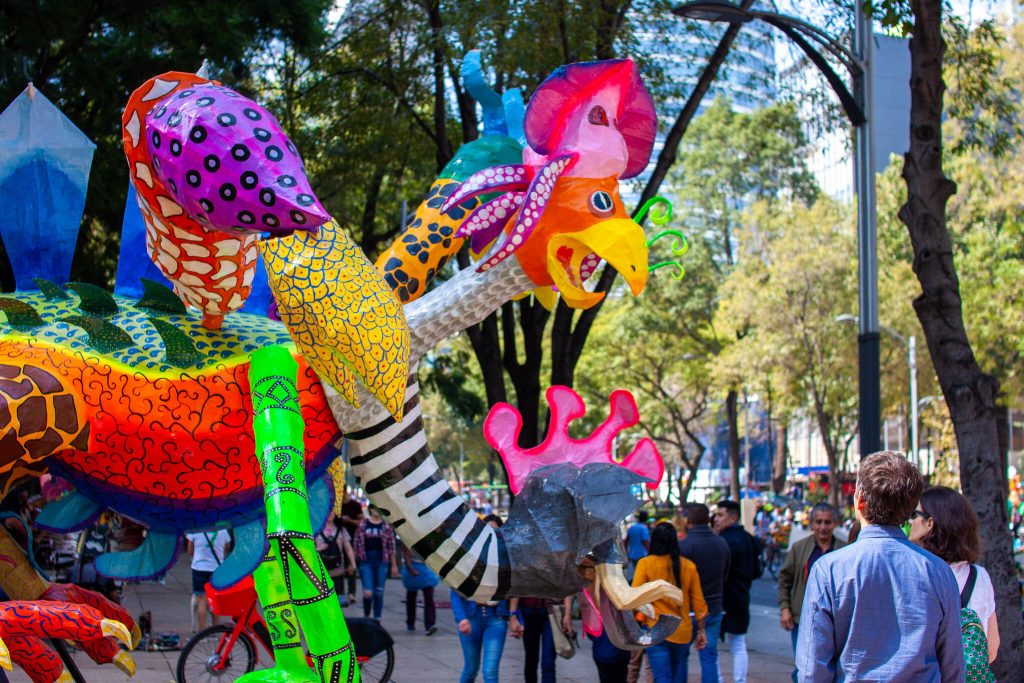
Shopping
Since there is such an influx of pedestrian traffic on Sundays, this is seen as a great opportunity for vendors to come out as well. If you’re looking for handicrafts, I was shocked to see how many sellers came out with their goods along the sidewalk. I thought perhaps that the prices might be a little inflated since it was a makeshift marketplace but after a week of shopping, I realized everything I bought here (even without haggling) was much cheaper than anywhere else in the city! And there were so many items I saw here that I never saw anywhere else, even the Artisan Market!
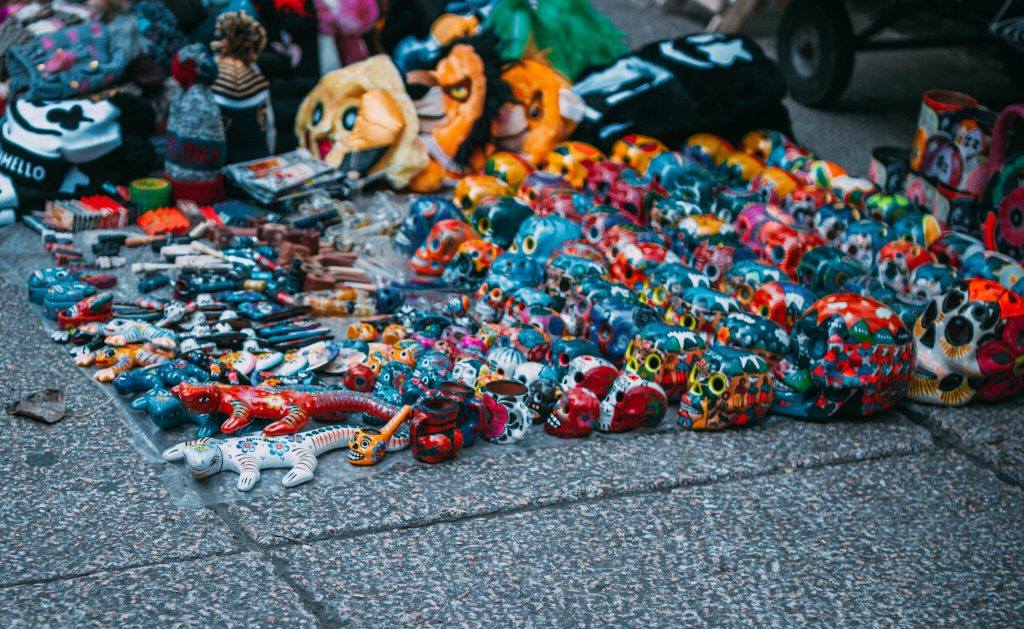
I always go with the motto that if you see something you like and can afford it, just buy it when you see it. Since you don’t know if you’ll ever find it again. I’ve passed on so many things I’ve found on the street, thinking I’ll either buy it later or find a better price, only to be disappointed later when neither of those things happen. And trust me, the regret was REAL!
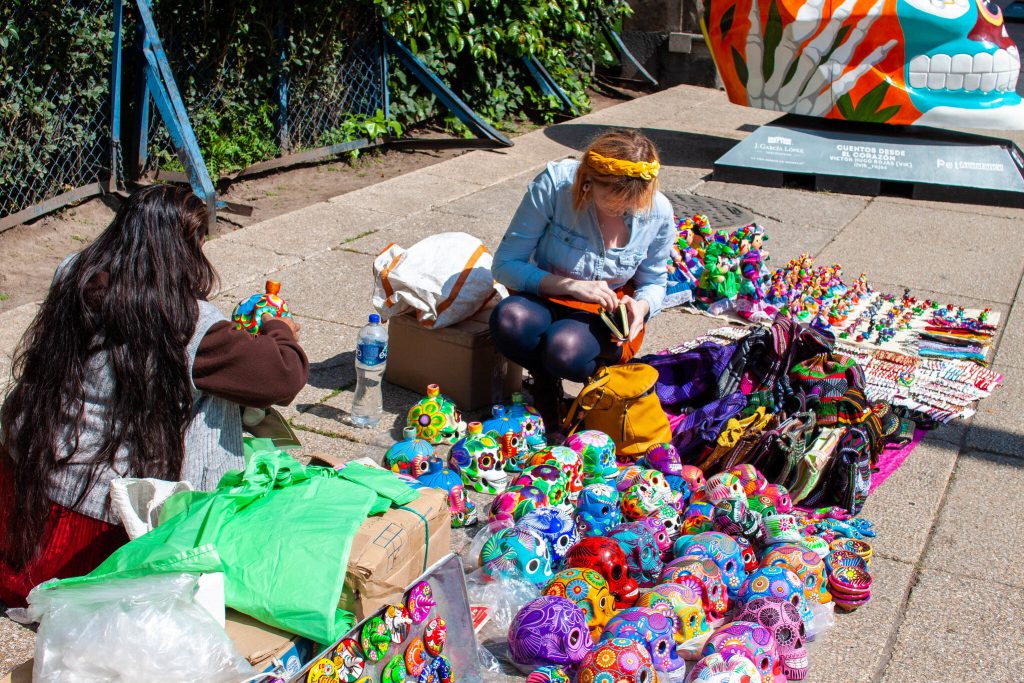
Street Food
In addition to souvenirs and handcrafted items, you’ll also find a ton of street food! All that activity can work up an appetite, so the food vendors are sure to be there to satisfy all your cravings. The fruits were my favourite choice since they were so cool after a hot ride out in the sun. I honestly think fresh cut fruit, covered in lime, chili and salt might be my favourite snack of all time!

The candy, nuts and dried fruit sellers were also another one of our favourite stands. You could get an entire bag of candy or nuts for 30 pesos! And the ones which were out here allowed you to mix and match so you could get a little bit of anything you wanted.
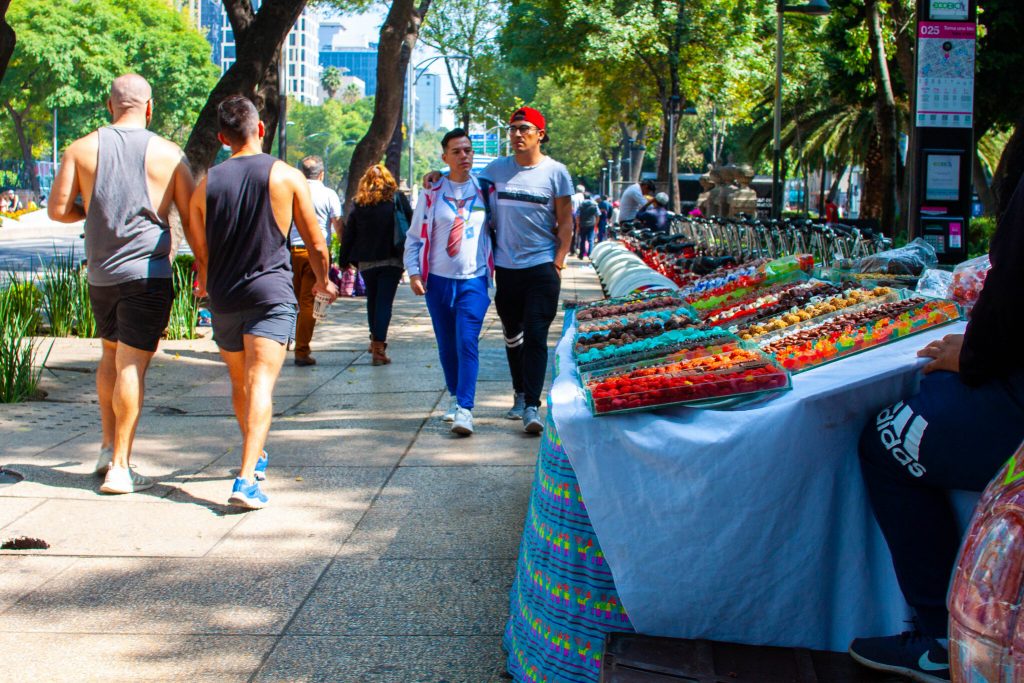
Self-Guided Tour of Paseo de la Reforma
While you can have such a great time just cruising down the avenue, enjoying the peaceful ride and beautiful environment, below is a little guide to the various monuments and buildings which are worth a quick stop beside to admire. I would recommend starting the day at the intersection of Río Ródano and the Avenue de la Reforma. Unless you’re picking up a free bike at the Glorieta de la Palma roundabout, Río Ródano is a great starting location as you have a gorgeous view all down the avenue as you begin your journey. If you do need to pick up a free bike at Glorieta de la Palma, just make a loop down to Río Ródano from Glorieta de la Palma to begin this tour.
Estela de Luz
At the start of Paseo de la Reforma, you’ll find the giant shining edifice, which is the Estela de Luz or Light Trail. This was a monument that was built in 2011 to commemorate the bicentenary of Mexico’s independence from Spanish rule. The steel structure is covered in quartz panels with aluminum frames. These are lit with electric LEDs, which create a spectacular light show at night. In the daytime, though, the quartz still reflects the sunlight creating an almost sparkling effect. This building was an incredibly contentious structure as it went massively over budget. Also, despite being designed for the bicentenary, construction delays resulted in it not being unveiled until well after the anniversary it was built for.
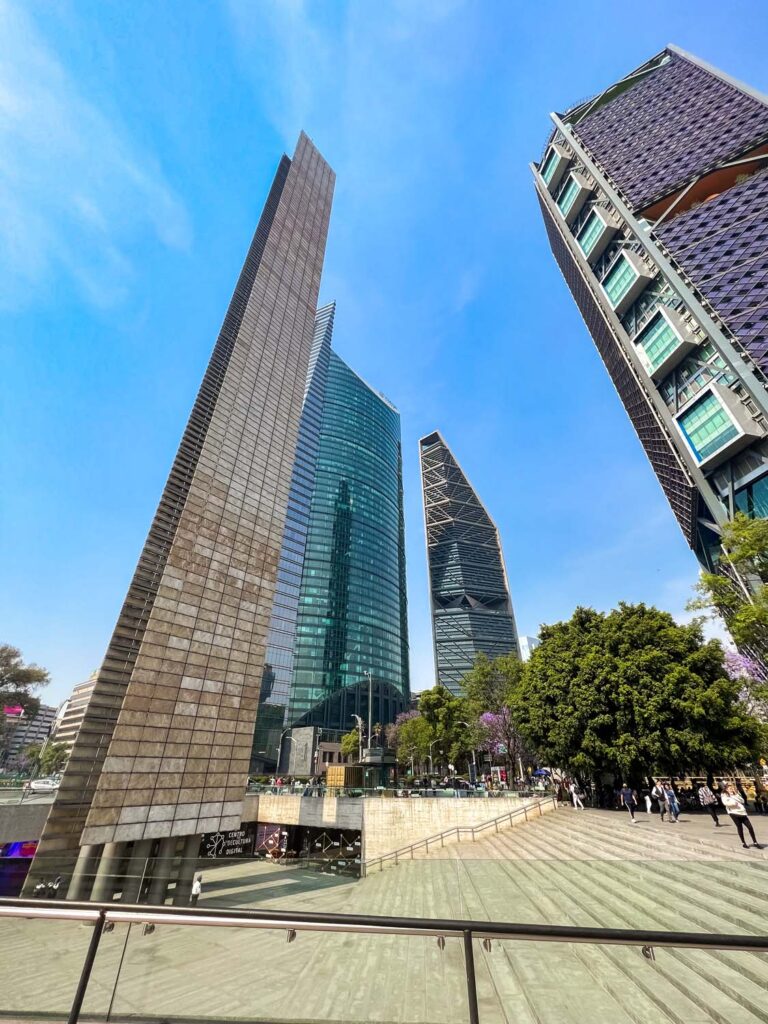
Torre Mayor
On the north side of the street as you set off is the Torre Mayor. The Torre Mayor (or Major Tower) is the third tallest building in Mexico, standing 225 meters tall with 55 stories going up! As someone who lives in Toronto, I found it interesting to learn that the building was designed and built by Canadians at architectural firms in Toronto, my home town! Although the building is astonishingly tall, it was built with a complex design to ensure it is earthquake resistant! It is designed to withstand earthquakes measuring 8.5 on the Richter Scale. The devastating earthquake which hit Mexico City in the 1980s hit 8.1 on the Richter Scale, so their hope was to ensure it could withstand an even stronger quake.
Diana the Huntress Fountain
At the intersection of Reforma and Sevilla, you’ll find the great fountain of Diana the Huntress. The fountain was built in 1942 when President Manuel Avila Camacho decided to start an initiative of beautification along the Paseo de la Reforma. Juan Francisco Olaguíbel sculpted the piece, and it was revealed to the public on October 10th, 1942. Despite its fantastical artistry, the sculpture was met with outrage by an ultra-conservative group called the “Decency League.” They were angered by the fact that the goddess was presented in the nude and insisted the artist create bronze underwear to cover her up. With much public pressure, he obliged, and the statue wore awkward and unbecoming bronze underwear for 25 years.
In 1968, Mexico City won the bid for the Olympics, and the committee thought it was time to do away with the ugly undergarment in favour of the original design. So finally, just before the Olympics, she was revealed to the world as the artist first intended. Today you can still see her holding her bow and arrow up towards the sky.
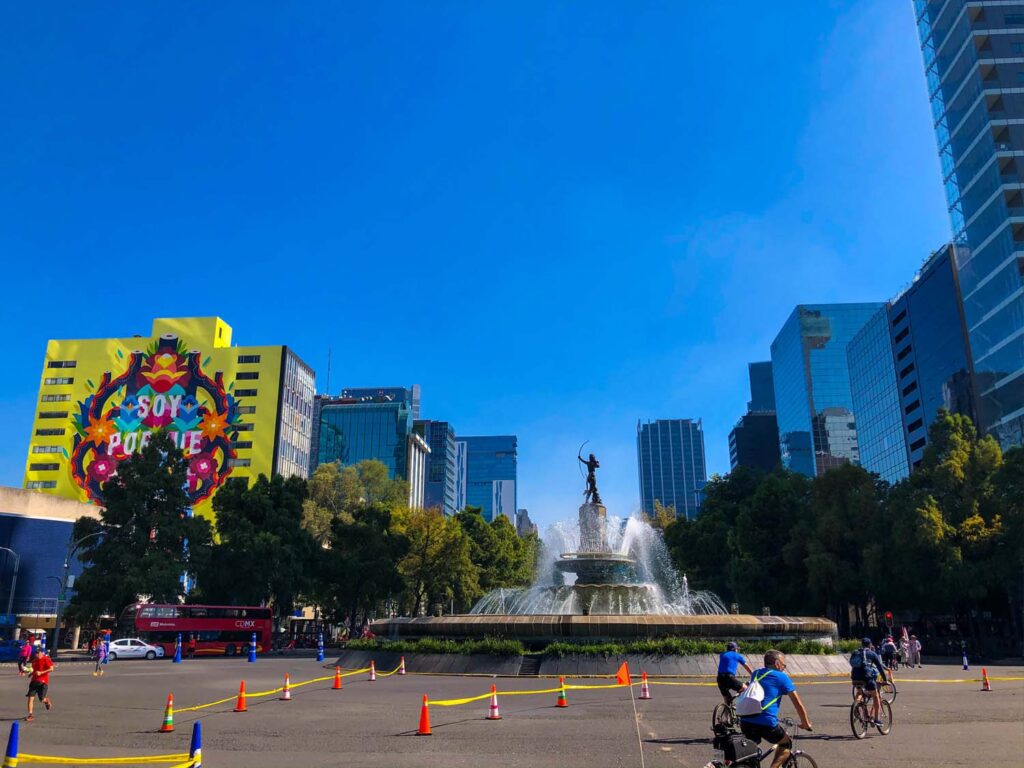
The Angel of Independence
One of the largest roundabouts along the street is marked by the golden Angel of Independence or Ángel de la Independencia. As someone who spent some time in Berlin, I thought upon first glance, I was back in Germany. And this is not just my age getting to me, the statue was designed to resemble the Berlin Victory Column located along their great promenade. President Porfirio Díaz requested its construction as a tribute for the centennial of Mexico’s War of Independence against the Spanish. Designed by architect Antonio Rivas Mercado, it was inaugurated in 1910. For years it became a meeting point for celebrations and protests, and throughout the years, it was also used as a mausoleum for heroes of the war of independence.

Antiques Center Plaza del Angel
If you’re looking to take a quick break, park your bike and head down to the Antiques Center Plaza del Angel. On Saturdays and Sundays, this complex houses antique vendors selling vintage stuff. There are plenty of super unique treasures you can uncover here spread out across this square.
Beatricita
If you’re hungry for more than just street food, check out Beatricita, just off the Paseo de la Reforma. Some people call this place the best tacos in the city! The restaurant was established by Beatriz Muciño Reyes, in 1887 when she immigrant to Mexico City with her brother Claudio. Together they opened this restaurant and have been serving up some of the best traditional Mexican cuisine at amazing prices, right in the heart of the city. If you’re there before lunch, try the chilaquiles with eggs, pork rinds in green salsa!
Miguel Ramos Arizpe
Along either side of the street, on the sidewalks, you’ll find various bronze statues on marble pillars, representing various important people from Mexico’s history. Just ahead of Angel of Independence on the south side of the street is the statue of Miguel Ramos Arizpe. Miguel Ramos Arizpe was a Mexican priest and politician and also known as the father of Mexican federalism.
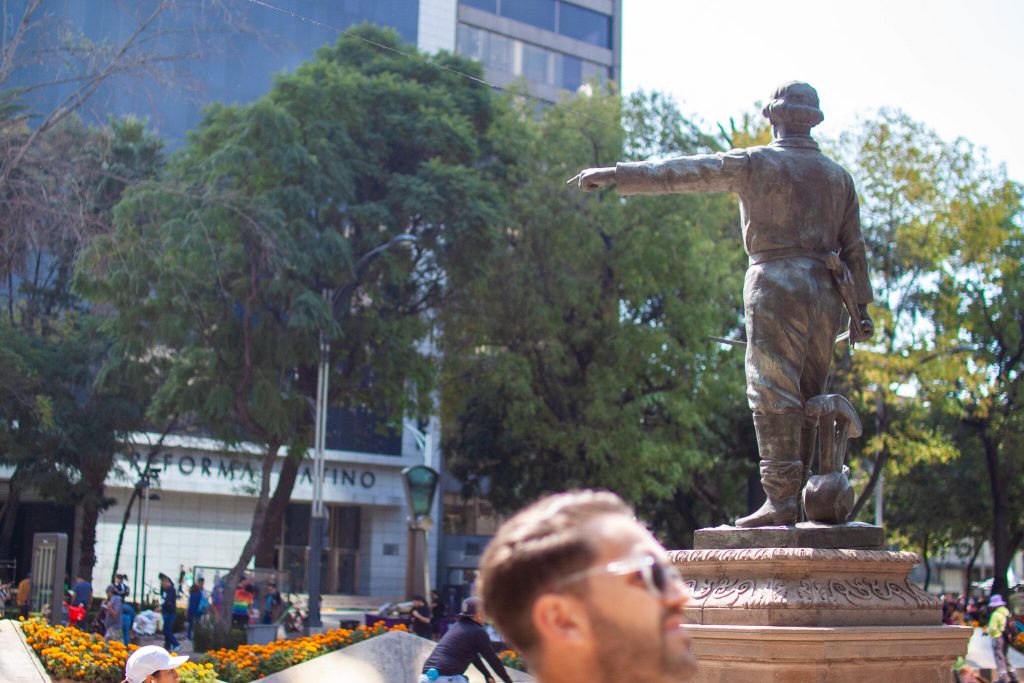
Glorieta de La Palma
The next roundabout you’ll come to is the Glorieta de La Palma. While the center of the roundabout doesn’t feature a statue or fountain, it does hold pride of place to the great palm tree, which gave the area its name. Palm trees are one of Mexico’s greatest exports, and today they can be found all over the world. They truly do deserve to be lauded just as much as the other historical personalities. One of the most impressive things to see at this roundabout while you’re waiting for the lights to change is the Bolsa Mexicana de Valores. The Bolsa Mexicana de Valores is where you can find the Mexican Stock Exchange. It was built inside this futuristic, disco ball-inspired building, which almost everyone ponders at as they pass by.
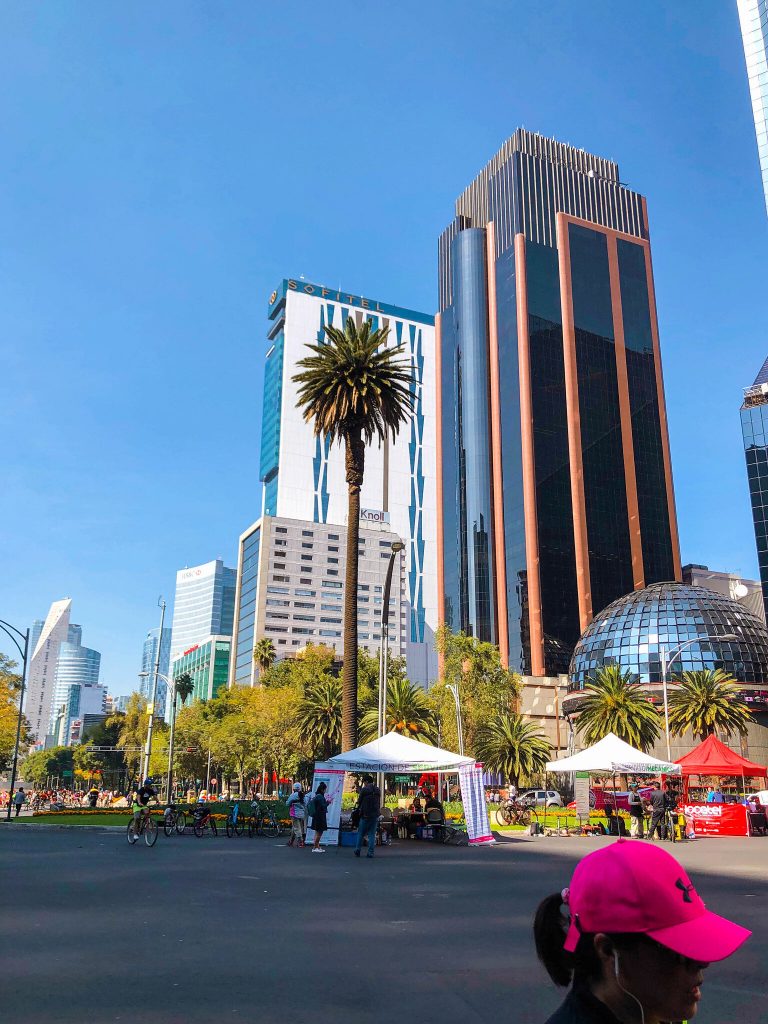
Monument to the Emperor Cuauhtémoc
Intersecting the Avenue des Insurgentes and Reforma is the monument dedicated to Emperor Cuauhtémoc. These two avenues are two of the largest and most important in the city and standing in the centre is, by no coincidence, one of the most critical figures in Mexico City’s history. Emperor Cuauhtémoc was the last Aztec ruler of Tenochtitlan (the Aztec name for Mexico City). He ruled only for a year, from 1520 to 1521, but his impact was enormous.
The name Cuauhtemōc means “one who has descended like an eagle.” Eagles attacked their prey, first by scoping them out from above, and then quickly plummeting, straight down, to attack and devour. This is a name that implies aggressiveness and determination. When Cuauhtémoc became emperor, he was an energetic 25-year old, whose beloved country was being attacked by the Spanish. They had brought not only the war but also a plague of smallpox, which was devastating his country.
Battle of 1519
Cuauhtémoc led the last battle of the Mexican people against the Spaniards in 1519. The Mexican army was defeated, and Cuauhtémoc was captured. He was subject to torture by fire to give up his people but never lamented. Scenes from this great torture can be found on a bas relief on the monument he stands upon. After months of pain, he was eventually executed by the Spanish, but his heroic memory lives on today.
Jardín del Arte
Take a little detour northwest, towards the Jardín del Arte. On Sundays, along the Rio Nevada, you can find the green gardens covered in the paintings and artworks from over 100 artists. If you’re looking for high quality artworks from Mexican artists, this is definitely the place to go!
Monument to Christopher Columbus
In complete opposition to the previous statue, the next roundabout is marked by the Monument to Christopher Columbus. It was made in 1877 by French sculptor Charles Cordier. Usually, when you pass this one by, you’ll see that it is covered in graffiti and protest signs since many locals would like it to be removed. The monument presents Columbus on top of a large pink pedestal. His arm stretched out, with his foot resting atop a globe beneath his feet. It presents Columbus as both the discoverer of the new world and the founder of the catholic church in Mexico.
Around the base of the pedestal are four other men, seated around Columbus, who represent the catholic missionaries who converted the native people of the Americas to Catholicism. Many Mexicans oppose this statue as it presents Columbus as the hero when many indigenous people see him as the man who took their great land and culture away from them. Over the years, there has been almost constant vandalization of the statue as a means of protest.
Plaza de la República
Take a short detour from here, up along Ignacio Ramírez towards the Plaza de la República. This enormous square is dominated by the imposing copper-domed Monumento a la Revolución (Monument of the Revolution). Designed by Mexican architect Carlos Obregón Santacilia, it is still today considered the tallest triumphal arch in the world. The project took over 27 years to complete due to multiple revolutions and changes in government. It originally was started as a project by French architect Émile Bénard who wanted the entire piece to be designed in French renaissance style. He even imported iron and marble from Italy rather than just using local materials.
But after the Mexican Revolution and a new, more nationalistic president, the project was handed over to Mexican architect Carlos Obregón Santacilia who dedicated the structure to the heroes of the Mexican Revolution. Santacilia removed the renaissance appearance from the facade and replaced it with the art deco style which was more prevalent in Mexico City. He also added his own unique socialist realism style to the designs as well. Surrounding the dome, Mexican sculptor Oliverio Martínez created four stone sculptural groups that represent Independence, the Reform Laws, Agrarian Laws, and Labor Laws. They stand facing the square, perhaps overseeing the people to ensure they are obeying those very laws. Today you can ride the glass elevator in the centre, 65 meters up into the observation deck where you have a great view all across the city.

Edificio El Moro
Head back down the Avenue de la República until you get to the intersection of Avenue Juarez and Reforma. Here stands the Edificio El Moro and the Loteria Nacional or National Lottery offices. These are located inside the fantastical art deco masterpiece Edificio El Moro. The building was designed in 1945 as one of the first skyscrapers in Mexico City and for a time, was the tallest building in the city.
The King of Spain Sculpture
In front of the building is a huge yellow, modernist sculpture designed by sculptor Sebastián. Sebastián is a world-renown sculptor who works primarily in steel to create fantastical abstract sculptures. This one he calls, King Carlos of Spain, as it is thought to mimic the shape of a king on horseback.
You can keep biking or scooting to your leisure from here, but I find that this extent of the roadway provides the most exciting things to see. Past this point, there is also little entertainment or food vendors. Sunday mornings in Reforma are honestly just the best thing you can do with your time. It allows you to explore the city in a relaxing and freeing way. See it from a unique perspective. Discover new foods along the sidewalks. Buy local handicrafts and more! It’s everything you want from Mexico City, all in one place! Hopefully, you can see it for yourself on your next trip to Mexico.
What is your favourite way of exploring a new city? Let me know in the comments.
Happy Travels Adventurers
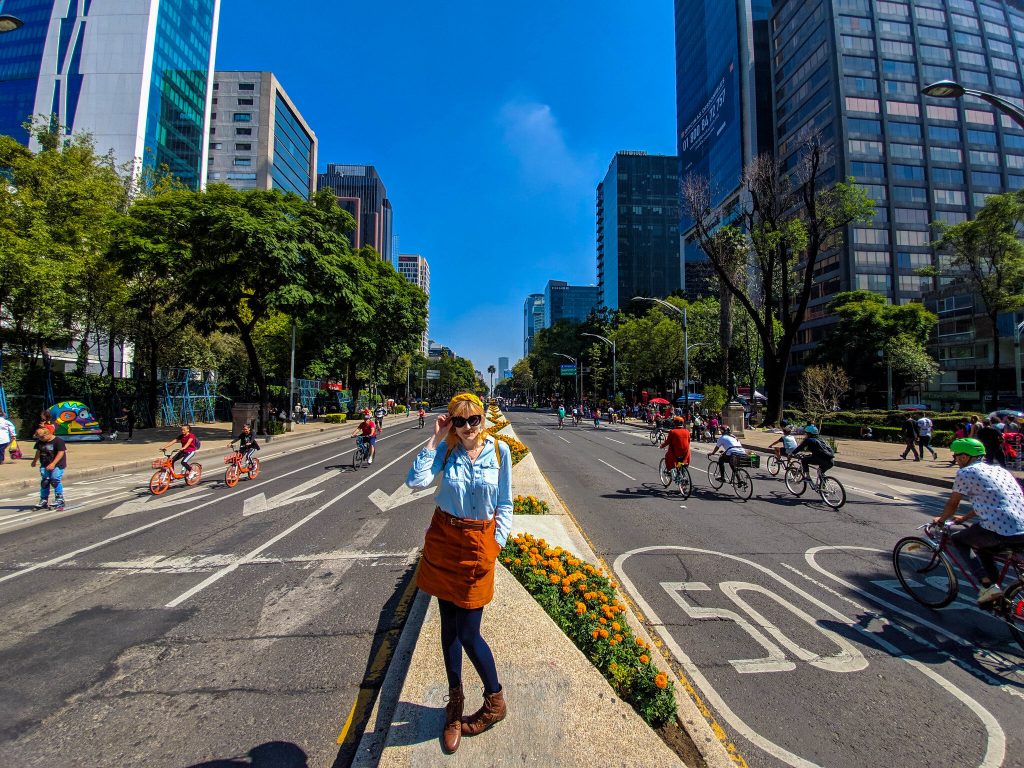
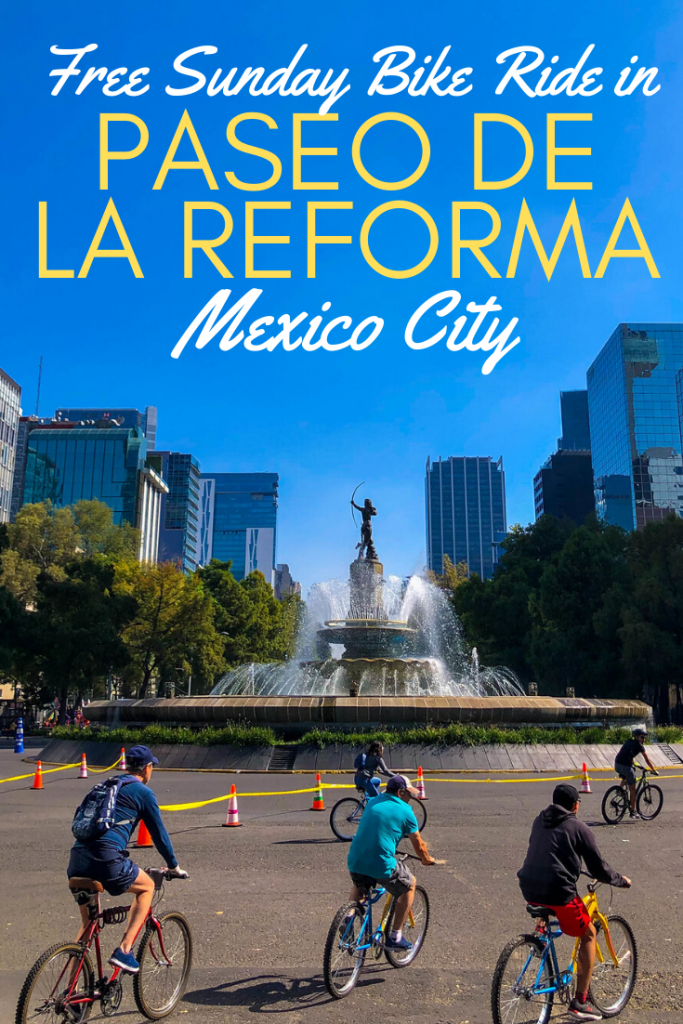
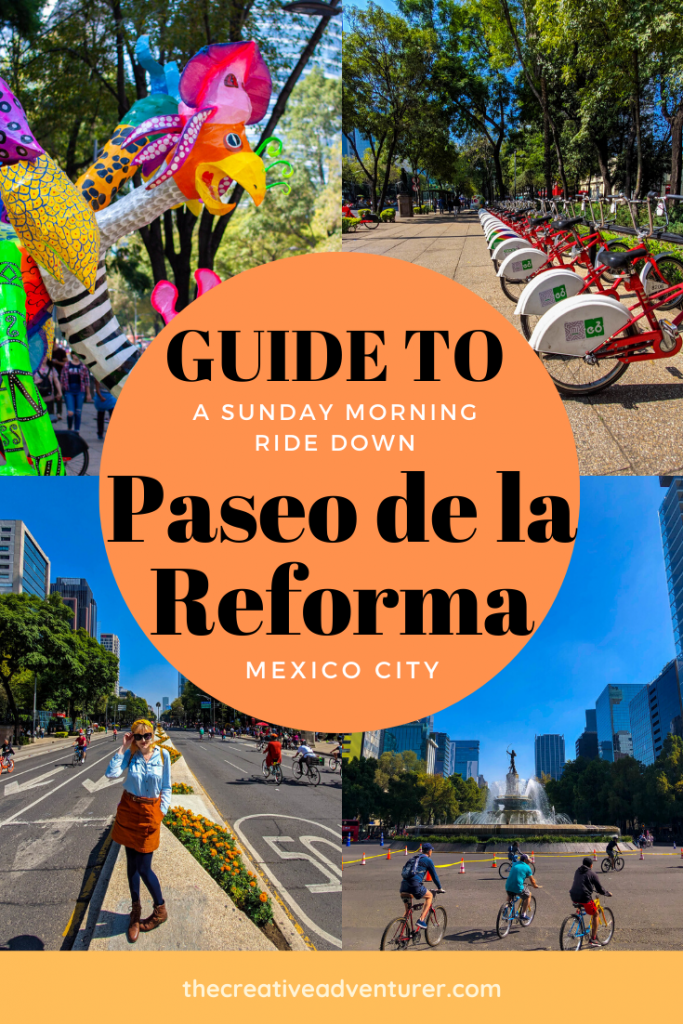



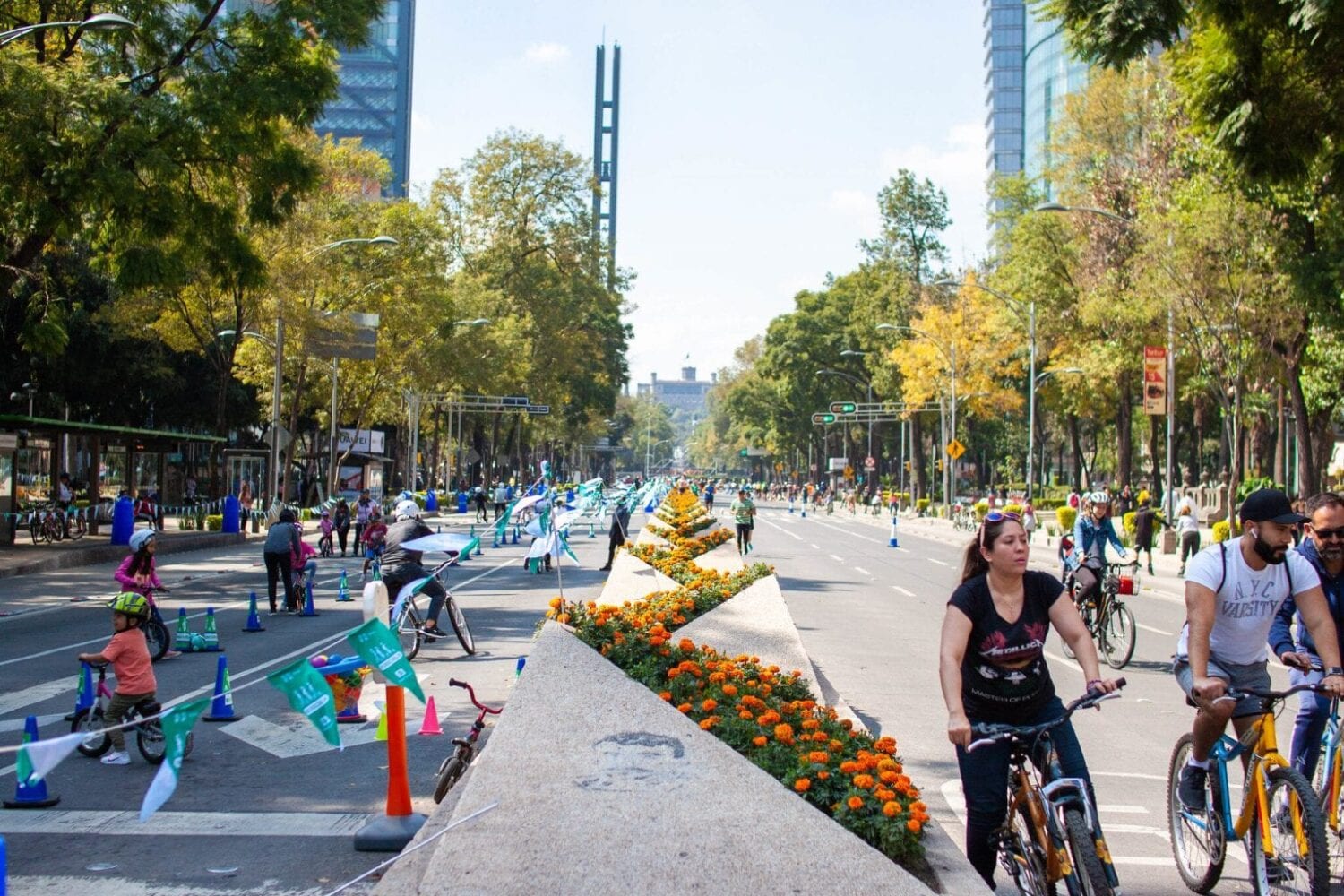
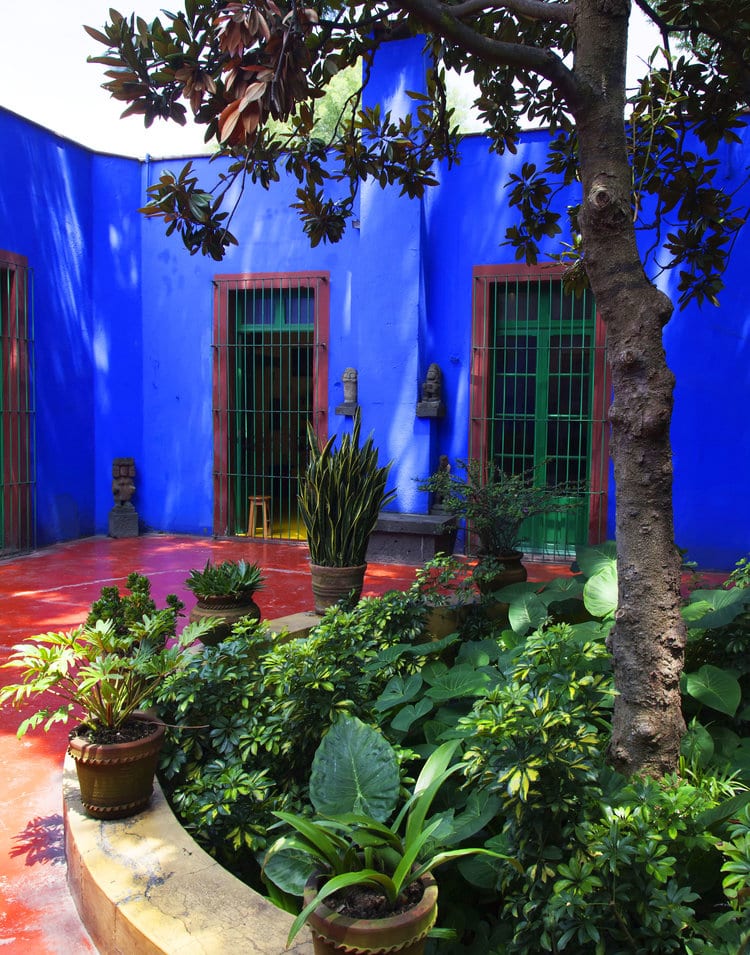
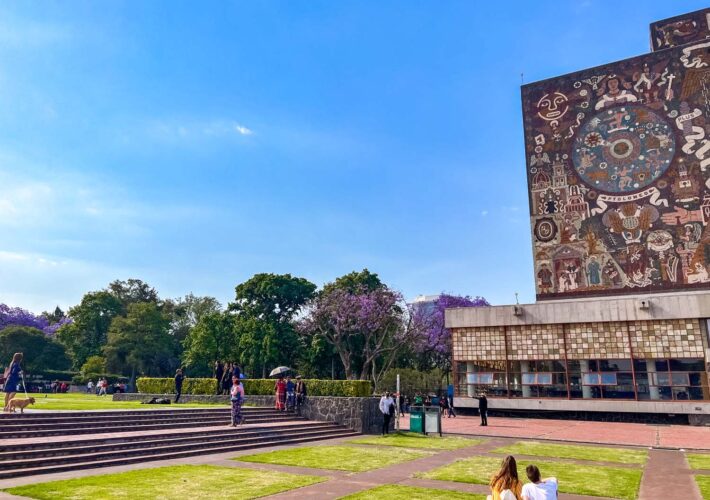
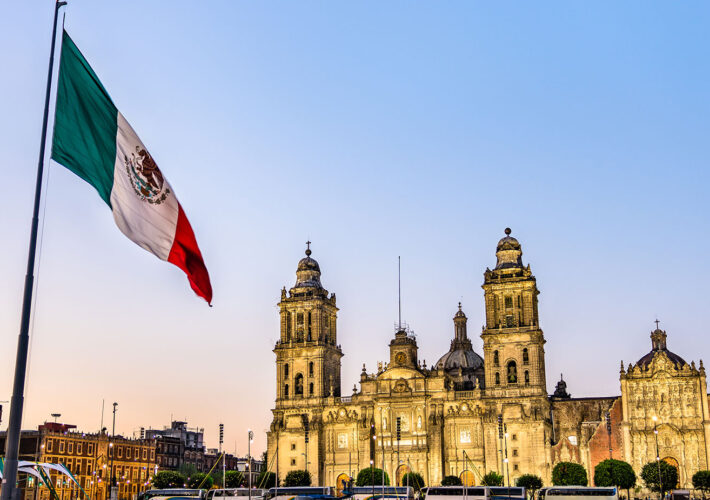
Leave a Comment